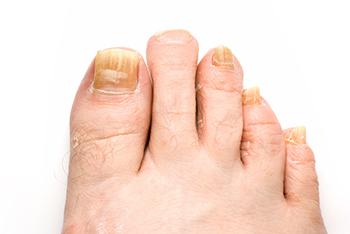
What is Onychomycosis?
Onych meaning nail, and mycosis meaning fungus is a fungal infection of the nail. This nail infection is caused by dermatophytes, a pathogenic fungus. It is important not to delay toenail fungus treatment, so first you will want to know what to look for.
You may notice a change in the appearance of your nail including discoloration. Your nail may start to become thickened, and there may be a flaky buildup under the nail causing a build up and thickening of the nail. The increase in pressure due to this thickening can be quite painful and may also make it difficult to trim your nails. The nail may become loose, and become detached, which can cause an underlying bacterial infection, which in turn can lead to a condition called cellulitis, a potentially serious skin infection.
What causes toenail fungus?
There are a number of factors that can contribute to toenail fungus. Some of these include a history of poor circulation, diabetes or any disease that compromises the immune system. Athlete’s foot can result in onychomycosis and fungal infection can spread from one toe to another. Our feet are an ideal breeding ground for fungus as those micro-organisms tend to thrive in warm, moist environments.
How do you know if you have toenail fungus?
If you suspect that you may have Onychomycosis, you should schedule an appointment with Dr. Gowdie to have your nail evaluated. Although the nail may show these signs, to definitively tell if you have a fungal infection of the nail, Dr. Gowdie may take a clipping of your nail and have it tested. This test will establish whether or not there is a fungal infection as well as identify the exact organism so that we can determine your best treatment options. This test is important because not every nail exhibiting the signs noted above are fungal. Other factors such as nutritional deficiency or micro trauma can cause your nails to appear fungal.
What is the most effective treatment for toenail fungus?
Treatment for Onychomycosis can be accomplished by using a topical, oral, or a combination of both. Laser therapy can also be an effective component of your toenail fungus treatment but, laser treatment alone will not be effective in treating severe cases. The laser is a non-painful treatment performed in the office. The laser uses narrow beams of light energy to disrupt fungal growth, alleviate pain and help prevent any further tissue damage. Dr. Gowdie and his staff will work with you to establish the most effective treatment plan.
Need to talk to someone?
Although a toenail fungus can be painful and all you read may seem a bit scary, you don’t have to go it alone. There are effective treatments and Dr. Gowdie and his staff are here to get you through it.
If you want more information about toenail fungus treatment, please call us at (706) 310-4288 or request an appointment online.
